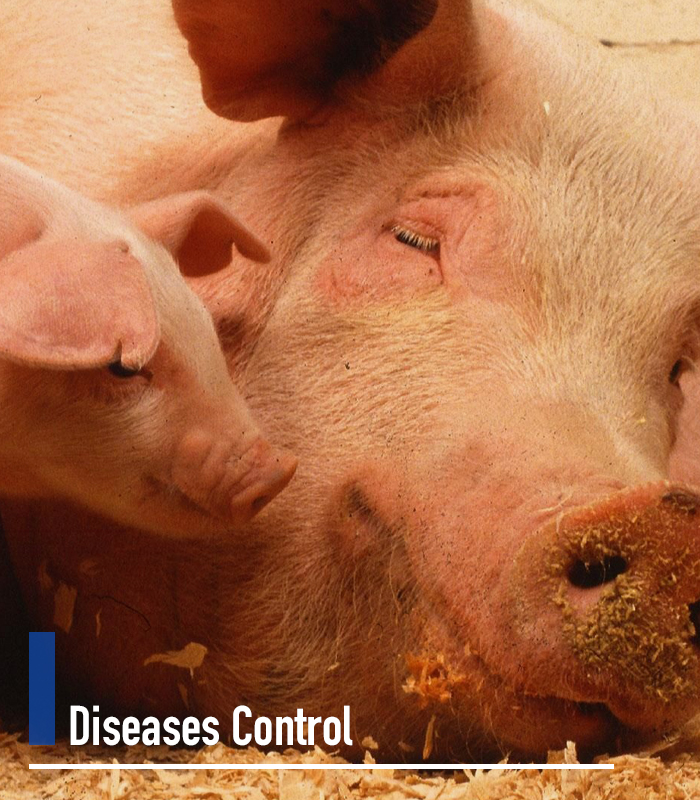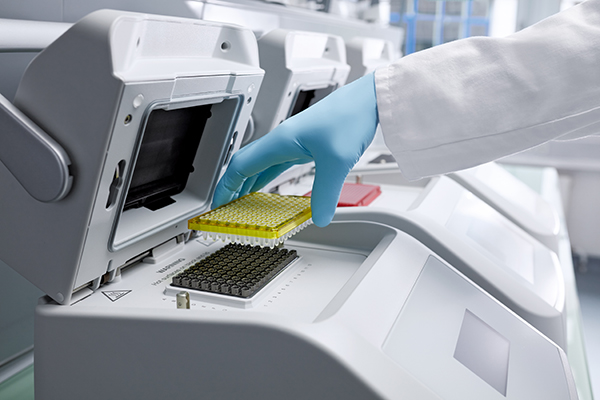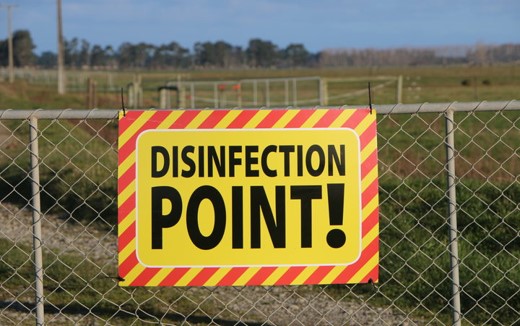

General precautions from OIE for commercial farmers:
- Declare any suspicious case (dead or alive) to the Veterinary Services
- Ensure that all your workers and visitors are aware of biosecurity rules
- Clean and disinfect material and equipment coming in or out
- Prevent direct or indirect contact with wild boar. Implement quarantine measures for new pigs on farm
- Do not feed untreated swill or kitchen scraps containing meat to your pigs
Clean and disinfect material and equipment coming in or out:
Cleaning and Disinfection
Goal: Prevent the Introduction of ASFV on Hard Surfaces
- Identify Line of Separation
- Mechanically remove all solid waste
- Apply appropriate detergent
- Wait appropriate amount of time for detergent to work
- Pressure wash the area with water. Use hot water where available.
- Audit area for cleanliness
- Apply appropriate disinfectant
- Allow disinfectant to dry
- If available, heat surface
Water Disinfection
Goal: Prevent the Introduction of ASFV via Drinking Water
- Identify Source of Drinking Water
- If surface water, consider converting to deep well
- Take water sample from source and at end of drinker line
- Install filters to collect large particles and minerals if needed
- Clean water lines regularly to minimize biology growth with an EPA-registered disinfectant
- After every turn
- Install Water Disinfection System
- Determine appropriate disinfection levels
- 3-5 ppm ClO2 is recommended at the end of the waterlines. Adjustments will be necessary based on ClO2 levels.
- Determine appropriate acidification levels based on water treatment program
- A 2:1 ClO2 to acid ratio is recommended; however, adjustments may be required to reach optimal levels.
- Continuously evaluate chemistry levels
- ClO2 test strips will provide an easy and economic solution to evaluate water treatment chemical concentrations. Weekly to Monthly evaluations will be important to ensure adequate water palatability, volume and quality.
Pest Control
Goal: Minimize pest populations to prevent the introduction of ASFV via vector introduction
- Identify level of infestation with an infrared surveillance system and/or performing a manual audit
- Maintain a minimum of 3 foot gravel barrier around all buildings
Mow and maintain weeds, grass and brush to help control rats, mice, and ticks from having easy access to facilities - Continuously apply rodenticides and insecticides inside and outside of barns
- Maintain continuous rotation programs to prevent resistance to active ingredients
- Evaluate effectiveness by performing monthly manual audits and conducting an infrared surveillance annually
The Human Element
Goal: Prevent the Introduction of ASFV via human movement
Develop a visitor control plan
- Ensure only invited visitors and employees have access to the premise
- Ensure all visitors utilize disposable boots, gloves, and coveralls prior to entering the facility
- Provide farm-specific attire to all visitors and employees who may have access to pigs
- Require all visitors and employees to follow the following programs where applicable:
- Shower-in/Shower-out
- Vehicle disinfection
- Boot bath disinfection
- Supply and equipment disinfection
- Any other farm-specific biosecurity protocols
- Require that no personal items are brought into the facility
- Perform regular evaluations and trainings to ensure all employees are aware of the biosecurity protocols on site
Laboratory diagnosis
Polymerase chain reaction (PCR)
PCR is used to detect the pathogen genome in porcine samples. Small fragments of viral nucleic acids are amplified by PCR to detectable quantities. All validated PCR tests allow viral nucleic acids detection even before the appearance of clinical signs. PCR enables the diagnosis to be made within hours of sample arrival to the laboratory. PCR provides a sensitive, specific, and rapid alternative to virus isolation for the detection of Virus. PCR provides higher sensitivity and specificity than alternative methods for antigen detection, such as the antigen enzyme-linked immunosorbent assay (ELISA) and the direct fluorescent antibody test (FAT). However, the extreme sensitivity of the PCR makes it susceptible to cross-contamination, and proper precautionary measures should be taken to minimize and control this risk.

Types of biological sample
a.Whole blood
b.Sera
c.Organs and tissue samples
d.Soft tick sample
e.Oral fluid
f.Swab
Prevention
The risk of introducing pathogen is reduced by adopting good biosecurity practices, not just on the farm, but at every step of the supply chain, e.g. at live-animal markets, slaughter sites, while transporting the animals, etc. Special attention should be paid to small commercial and backyard operations, which are characterized by low biosecurity standards, and to live-animal markets, which bring together animals from many sources. Both are key in the spread of disease, and although the same biosecurity concepts apply, specific measures and manuals have been specifically developed for them.

General precautions from OIE for commercial farmers:
- Declare any suspicious case (dead or alive) to the Veterinary Services
- Ensure that all your workers and visitors are aware of biosecurity rules
- Clean and disinfect material and equipment coming in or out
- Prevent direct or indirect contact with wild boar. Implement quarantine measures for new pigs on farm
- Do not feed untreated swill or kitchen scraps containing meat to your pigs
Clean and disinfect material and equipment coming in or out:
Cleaning and Disinfection
Goal: Prevent the Introduction of ASFV on Hard Surfaces
- Identify Line of Separation
- Mechanically remove all solid waste
- Apply appropriate detergent
- Wait appropriate amount of time for detergent to work
- Pressure wash the area with water. Use hot water where available.
- Audit area for cleanliness
- Apply appropriate disinfectant
- Allow disinfectant to dry
- If available, heat surface
Water Disinfection
Goal: Prevent the Introduction of ASFV via Drinking Water
- Identify Source of Drinking Water
- If surface water, consider converting to deep well
- Take water sample from source and at end of drinker line
- Install filters to collect large particles and minerals if needed
- Clean water lines regularly to minimize biology growth with an EPA-registered disinfectant
- After every turn
- Install Water Disinfection System
- Determine appropriate disinfection levels
- 3-5 ppm ClO2 is recommended at the end of the waterlines. Adjustments will be necessary based on ClO2 levels.
- Determine appropriate acidification levels based on water treatment program
- A 2:1 ClO2 to acid ratio is recommended; however, adjustments may be required to reach optimal levels.
- Continuously evaluate chemistry levels
- ClO2 test strips will provide an easy and economic solution to evaluate water treatment chemical concentrations. Weekly to Monthly evaluations will be important to ensure adequate water palatability, volume and quality.
Pest Control
Goal: Minimize pest populations to prevent the introduction of ASFV via vector introduction
- Identify level of infestation with an infrared surveillance system and/or performing a manual audit
- Maintain a minimum of 3 foot gravel barrier around all buildings
Mow and maintain weeds, grass and brush to help control rats, mice, and ticks from having easy access to facilities - Continuously apply rodenticides and insecticides inside and outside of barns
- Maintain continuous rotation programs to prevent resistance to active ingredients
- Evaluate effectiveness by performing monthly manual audits and conducting an infrared surveillance annually
The Human Element
Goal: Prevent the Introduction of ASFV via human movement
Develop a visitor control plan
- Ensure only invited visitors and employees have access to the premise
- Ensure all visitors utilize disposable boots, gloves, and coveralls prior to entering the facility
- Provide farm-specific attire to all visitors and employees who may have access to pigs
- Require all visitors and employees to follow the following programs where applicable:
- Shower-in/Shower-out
- Vehicle disinfection
- Boot bath disinfection
- Supply and equipment disinfection
- Any other farm-specific biosecurity protocols
- Require that no personal items are brought into the facility
- Perform regular evaluations and trainings to ensure all employees are aware of the biosecurity protocols on site
Laboratory diagnosis
Polymerase chain reaction (PCR)
PCR is used to detect the pathogen genome in porcine samples. Small fragments of viral nucleic acids are amplified by PCR to detectable quantities. All validated PCR tests allow viral nucleic acids detection even before the appearance of clinical signs. PCR enables the diagnosis to be made within hours of sample arrival to the laboratory. PCR provides a sensitive, specific, and rapid alternative to virus isolation for the detection of Virus. PCR provides higher sensitivity and specificity than alternative methods for antigen detection, such as the antigen enzyme-linked immunosorbent assay (ELISA) and the direct fluorescent antibody test (FAT). However, the extreme sensitivity of the PCR makes it susceptible to cross-contamination, and proper precautionary measures should be taken to minimize and control this risk.

Types of biological sample
a.Whole blood
b.Sera
c.Organs and tissue samples
d.Soft tick sample
e.Oral fluid
f.Swab
Prevention
The risk of introducing pathogen is reduced by adopting good biosecurity practices, not just on the farm, but at every step of the supply chain, e.g. at live-animal markets, slaughter sites, while transporting the animals, etc. Special attention should be paid to small commercial and backyard operations, which are characterized by low biosecurity standards, and to live-animal markets, which bring together animals from many sources. Both are key in the spread of disease, and although the same biosecurity concepts apply, specific measures and manuals have been specifically developed for them.

